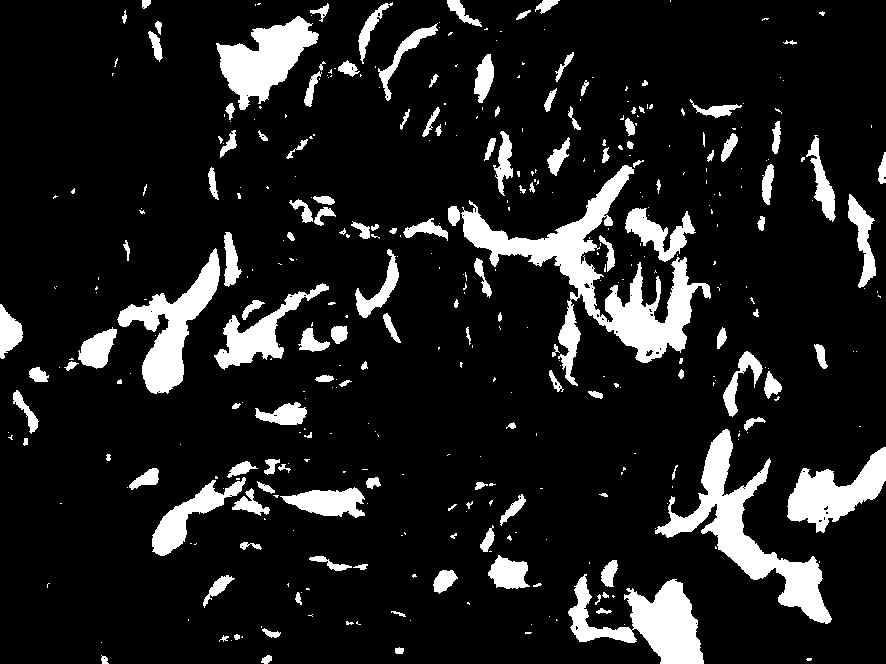Method for preparing xenogeneic acellular matrix and product thereof
A decellularized matrix and heterogeneous technology, applied in medical science, prostheses, etc., can solve the problems of unsatisfactory porosity and through-porosity, residual cell components, lack, etc., and achieve simplified residual treatment procedures, thorough decellularization, and saving cost effect
- Summary
- Abstract
- Description
- Claims
- Application Information
AI Technical Summary
Problems solved by technology
Method used
Image
Examples
Embodiment 1
[0048] 1.0 Preparation of split skin slices: use a skin harvester to make animal skin slices with a length of 6 cm, a width of 4 cm, and a thickness of 0.6 mm, wash with pure water, sterilize and degrease with 0.15% bromogeramine for 30 minutes, wash with 100 ml of PBS each time, and wash 3 times , the effect picture of HE staining of pig medium-thick skin obtained from the treatment is shown in figure 2 .
[0049] 2.0 Separation of epidermis and dermis: Use 100ml of 0.15% trypsin-PBS solution, stop at 7°C for 24 hours.
[0050] 3.0 Cross-linking: use 100ml ethanol solution (volume ratio of ethanol is 40%), add morpholineethanesulfonic acid (MES) monohydrate to make the concentration reach 0.06mol / L, then add N,N-dicyclohexyl to the solution Carbodiimide (DCC) and N-hydroxysuccinimide (NHS), according to the mass ratio, 1.8 grams of N,N-dicyclohexylcarbodiimide and 0.415 grams of NHS per gram of decellularized tissue, soaked for 4 Hour.
[0051] 4.0 Decellularization: Trea...
Embodiment 2
[0055] 1.0 Preparation of split skin slices: use a skin harvester to make animal skin slices with a length of 6 cm, a width of 4 cm, and a thickness of 0.6 mm, wash with pure water, sterilize and degrease with 0.1% bromogeramine for 30 minutes, wash with 100 ml PBS each time, and wash 3 times .
[0056] 2.0 Separation of epidermis and dermis: use 0.1% trypsin-PBS solution 100ml, stop at 4°C for 6 hours.
[0057] 3.0 Cross-linking: Use 100ml of ethanol solution (volume ratio of ethanol is 40%), add morpholineethanesulfonic acid (MES) monohydrate to make the concentration reach 0.06mol / L. Add N,N-dicyclohexylcarbodiimide and N-hydroxysuccinimide (NHS) to the solution, and the mass ratio is 5.4 grams of N,N-dicyclohexylcarbodiimide per gram of decellularized tissue imine and 1.245 g NHS, soaked for 4 hours.
[0058] 4.0 Decellularization: Treat with 100ml of 2% sodium hydroxide solution for 24 hours, then treat with 0.1% trypsin-PBS solution at 4°C for 36 hours. Rinse with PBS...
Embodiment 3
[0062] 1.0 Preparation of split skin slices: Use a skin harvester to make animal skin slices with a length of 6 cm, a width of 4 cm, and a thickness of 0.6 mm, wash with pure water, sterilize and degrease with 0.15 bromogeramine for 30 minutes, wash each time with 100 ml of PBS, and wash 3 times.
[0063] 2.0 Separation of epidermis and dermis: use 0.5% trypsin-PBS solution 100ml, stop at 20°C for 4 hours.
[0064] 3.0 Cross-linking: Use 100ml of ethanol solution (volume ratio of ethanol is 40%), add morpholineethanesulfonic acid (MES) monohydrate to make the concentration reach 0.06mol / L. Add N,N-dicyclohexylcarbodiimide and N-hydroxysuccinimide (NHS) to the solution, and the mass ratio is 3.6 grams of N,N-dicyclohexylcarbodiimide per gram of decellularized tissue imine and 0.930 g NHS, soaked for 4 hours.
[0065] 4.0 Decellularization: Treat with 100ml of 1.5% sodium hydroxide solution for 24 hours, then treat with 0.5% trypsin-PBS solution at 20°C for 20 hours. Rinse wit...
PUM
 Login to View More
Login to View More Abstract
Description
Claims
Application Information
 Login to View More
Login to View More - R&D
- Intellectual Property
- Life Sciences
- Materials
- Tech Scout
- Unparalleled Data Quality
- Higher Quality Content
- 60% Fewer Hallucinations
Browse by: Latest US Patents, China's latest patents, Technical Efficacy Thesaurus, Application Domain, Technology Topic, Popular Technical Reports.
© 2025 PatSnap. All rights reserved.Legal|Privacy policy|Modern Slavery Act Transparency Statement|Sitemap|About US| Contact US: help@patsnap.com


